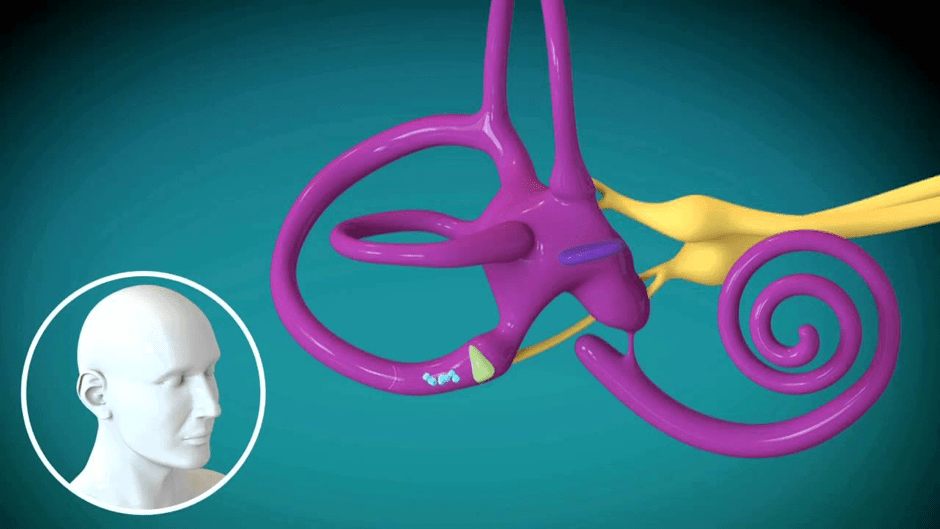Benign Paroxysmal Positional Vertigo (BPPV)
Symtoms of Benign Paroxysmal Positional Vertigo (BPPV)?
BPPV usually causes intense, brief episodes of dizziness or vertigo associated with moving the head, often when rolling over in bed or getting up in the morning. Some people may also feel nauseous between episodes of vertigo.
BPPV occurs when tiny crystals break loose and fall into the wrong part of the vestibular system in the inner ear, stimulating the nerves that detect head rotation. The brain receives the message that the head is spinning, although the head has only moved position slightly. BPPV is the most common cause of vertigo.

Vertigo is described as feeling like you are turning around when you are standing still. The experience is similar to how you feel when spinning on a playground roundabout. Vertigo has also been described as the sensation of standing still within a spinning room.
BPPV tends to come and go for no apparent reason. You may have attacks of vertigo for a few weeks, then a period of time with no symptoms at all. Usually, BPPV affects only one ear. Other names for BPPV include benign postural vertigo, positional vertigo and top-shelf vertigo (because you get dizzy looking up).
Causes of BPPV
Inside the inner ear is a series of canals filled with fluid. These canals are oriented at different angles. When the head is moved, the rolling of the fluid inside these canals tells the brain exactly how far, how fast and in what direction the head is moving.
BPPV is thought to be caused by little calcium carbonate crystals (otoconia) coming loose within the canals. Usually, these crystals are held in special reservoirs within other structures of the inner ear (saccule and utricle).
Imagine a hill with blades of grass, and on top of each blade is a crystal. Together, these crystals form an interconnected matrix. Whenever the blades of grass move, so do the crystals.”
The blades of grass represent cilia, hair-like processes that are attached to tiny nerves in your inner ear. When the crystals move, it stimulates the nerves to fire, which tells the brain your head is moving. This crystal matrix serves as a reliable motion-sensing map — until crystals break free, drifting into one of the ear’s three semicircular “balance” canals, and create havoc.
It is thought that injury or degeneration of the utricle may allow the ‘crystals’ to escape into the balance organ and interfere with the fluid flow.
BPPV can be caused by:
- head injury
- degeneration of the vestibular system in the inner ear due to ageing (>65yo)
- damage caused by an inner ear disorder.
- viral inner ear infections.
There is also an association between BPPV and osteoporosis. However, in a large number of cases, there is no known cause.
Diagnosis of BPPV
Diagnosis of the condition may be made based on:
- your medical history
- answers to questions about when and where the symptoms occur
- a physical examination
- results of special balance tests.
A health professional experienced in the treatment of BPPV will use a diagnostic test to look for the ‘jumping’ of the eyes (nystagmus) that is seen in people with BPPV. This test is called the Dix-Hallpike test and can be performed in the health professional’s rooms.
Treatment for BPPV
BPPV can be treated with simple exercises, taught by a doctor or physiotherapist who is familiar with the techniques required. However, if symptoms persist and cause distress, you may be referred to a specialist.
Very short-term use of motion sickness medications is sometimes useful to control the nausea associated with BPPV, and a number of easily learnt manoeuvres and exercises can be very effective treatments.
BPPV can subside with time, but it is important to seek treatment in the early stages to prevent falls or injury. In extreme cases, surgery may be carried out to block the affected canal, however BPPV can usually be very effectively treated using a range of positional manoeuvres.
These positional manoeuvres aim to move the crystals out of the semicircular canal of the inner ear and into an area of the inner ear where they no longer cause dizziness.
Sometimes, a second treatment may be necessary. Your health professional can perform these manoeuvres in their rooms. Treatment may also include other simple exercises that you will need to do regularly at home.
Where to get help
- Your GP
- Ear Nose and Throat specialist
- Specialist physiotherapist
- Vestibular physical therapist
- Audiologist
